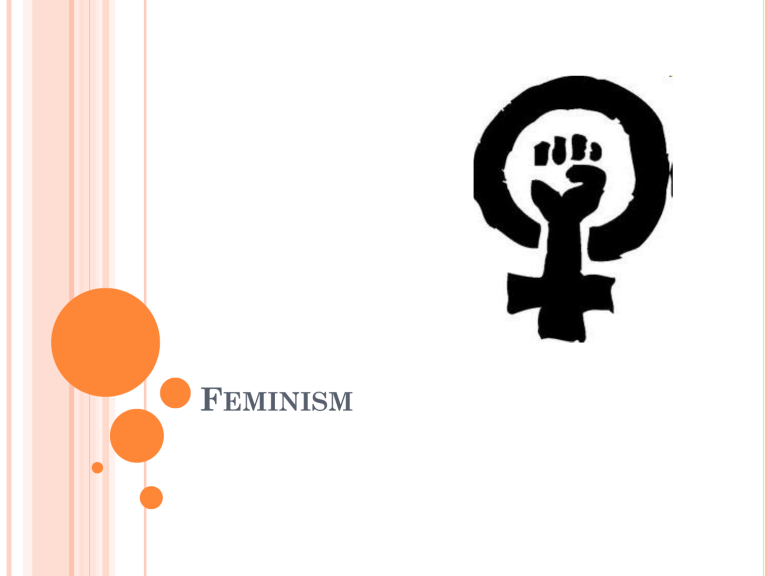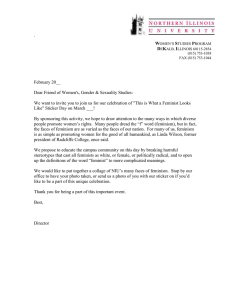
FEMINISM FEMINISM Feminists seek to challenge the unfair and unequal distribution of power and wealth in patriarchal society. A patriarchal society is one based on male rule and domination. Feminists are particularly interested in the contribution made by the media to society’s dominant ideas about gender roles. GENDER ROLES The mass media play a crucial role in socialisation – teaching us how to behave and think in ways that our culture finds acceptable. Sex is biological, gender is CULTURAL. What does it mean to be a woman/man? GENDER STEREOTYPES Femininity Caring Nurturing Emotional Domestic Sensitive Passive Lower Soft status...poorl y paid work – Gentle childcare, nursing, teaching Masculinity Tough Providing Rational Public/work orientated Thick skinned Higher Active status...Influenti Rough al roles...well paid Hard Imbalance of power jobs...political leadership STEREOTYPING Feminists have made great progress in eroding those stereotypes. However, some may argue that they have been replaced by equally disempowering stereotypes... Vicky Pollard clip FIRST WAVE FEMINISM Mid 19th – early 20th century. Fight for social and political equality. Struggle for women’s suffrage (right to vote) Key concerns included education, employment and marriage laws. Successes – higher education for women, married women’s property rights and the widening of access to professions such as medicine. SECOND WAVE FEMINISM Liberation movement of 1960s and 1970s. Characterised by struggles for equal pay, equal rights at work and better representation in public bodies such as Parliament. Access to contraception. Highly publicised activism. Miss America 1968 Stereotype of humourless, dowdy, man-hating feminist. Made in Dagenham clip LAURA MULVEY (1975) Visual Pleasure and Narrative Cinema The ‘male gaze’ The main source of visual pleasure in the cinema is the voyeuristic make viewer enjoying the image of the female body, Much of our media output assumes the spectator is male or constructs reality from a male POV. Women see themselves through the eyes of men. In order for a woman to experience pleasure from the film, she has to position herself in a similar role to the male viewer enjoying the spectacle. THIRD WAVE FEMINISM 1980s and 1990s Less emphasis on battles for equality More emphasis on the positive nature of ambiguity and difference (not all women are the same, it doesn’t matter) Spice girls and girl power Empowering heroines – Buffy and Xena. NAOMI WOLF (1991) The Beauty Myth “Beauty is a currency like the gold standard. Like any economy, it is determined by politics and in the modern age in the West, it is the last, best belief system that keeps male domination intact.” Images of ultra thin supermodels and the ‘perfect bodies’ glamourised by the media are indications of a patriarchal attack on women’s bodies. Women’s bodies and female sexuality have become commodities and the consequences are mental/physical illness, starvation diets and eating disorders. ANGELA MCROBBIE (1990) Girls’ magazines Magazines work alongside other socialising influences to reinforce an obsession with romance. They work ideologically to define for their audience the domestic roles of wife and mother that they should accept and embrace. POST FEMINISM Celebrates the diversity of identity available to women. Positive endorsement of consumerism Sometimes seen as ‘anti feminism’ If women know that femininity is a construct, then they can play with its signs, symbols and identities from a position of power Semiotic guerrilla warfare – meaning of signifiers such as high heels/lipstick/designer clothes can be shifted from powerless to powerful. GAUNTLETT (2002) “Men and women are seen working side by side, as equals, in the hospitals, schools and police stations of television land. Movie producers are wary of having women as screaming victims, and have realised that kick ass heroines do better business. Advertisers have now realised that audiences will only laugh at images of the pretty housewife, and have reacted by showing women how to be sexy at work instead.” CNN clip THEORETICAL PERSPECTIVES Liberal Feminism Socialization is the origin of gender differences. The goal: Gender Justice. Mary Wollstonecraft (1759-1797) John Stuart Mill (1806-1873) & Harriet Taylor Mill (18071858) Betty Friedan – wrote The Feminine Mystique in 1963. Critique – some flaws that seem to come from this way of thinking: 1. The claim that women can become like men if they set their minds to it. 2. The claim that most women want to become like men. 3. The claim that all women should want to become like men, to aspire to masculine values. THEORETICAL PERSPECTIVES Marxist Feminism Class accounts for women’s status and function in society. Monogamous marriage is about private property. The family is a microcosm of society’s larger class relations. Socialist Feminism Class and gender intersect. Both patriarchy and capitalism must be analyzed. THEORETICAL PERSPECTIVES Cultural Feminism There are fundamental differences between men and women, and women’s differences should be celebrated. There is an attempt to recover lost or marginalized women’s works and traditions and create a culture that nurtures and supports women’s experiences. What is meant by “essentialism”? A belief in the real, true essence of things. (Sexuality and/or gender is determined by an individual’s biology or psychology). GENDER ROLE SOCIALIZATION Consider common agents of Gender Role Socialization (e.g., family, schools, peers, media) Theories: Freud’s Psychoanalytic Theory – The key is the process of identification (the process by which a person internalizes a set of behaviors, attitudes, and characteristics exhibited by someone very close to the individual). Children unconsciously model the behavior of their parents. Object Relations Theory – Humans are fundamentally relationship-seeking. We form relationships with people and with things. We gender-identify with our same-sex parent. GENDER AND CULTURE Verbal Rituals – do we see differences in language patterns and use by gender? e.g., “report talk” vs. “rapport talk” use of “hedges” and “tag questions” Popular Culture – Those elements of culture that are widely accessible. Think about the portrayal of women and men in pop culture. What messages are relayed? GENDER AND CULTURE Media Theories Cultivation Theory – Television is a homogenizing agent in culture. Because television is a shared experience of most everyone, it causes all of us to view the world in a similar fashion. The Reflection Hypothesis – Reality shapes what we see in the media. Role-Learning Theory – Viewers internalize what they see in the media. Organizational Theories – Women and people of color are absent from the power positions where ideas and images are produced. Cultural Studies – An approach that studies the meanings that consumers actively construct from popular culture. WHAT IS FEMINISM? Feminism is a diverse, competing, and often opposing collection of social theories, political movements, and moral philosophies, largely motivated by or concerning the experiences of women, especially in terms of their social, political, and economic inequalities. “IS FEMINISM DEAD?” (7-15-98) TYPES OF FEMINISM A diverse, competing, and often opposing collection of social theories, political movements, and moral philosophies Three main differences Emphasize unique qualities of women? Integrate issues of culture and class into viewpoint? Advocate for rejection of masculine or patriarchal models? TYPES OF FEMINISM Liberal Feminism Emphasis on equality of women & men Aims to change current legal structures and interventions to promote access for women Criticized (by other feminists) for trying to be like men TYPES OF FEMINISM Cultural Feminism Emphasizes differences between men & women Values unique female qualities Gender interacts with race, social class, and other factors “We found that one important source of healing emerged when we got in touch with all the factors in our lives that were causing particular pain. For black females, and males too, that means learning about the myriad ways racism, sexism, class exploitation, homophobia, and various other structures of domination operate in our daily lives to undermine our capacity to be self-determining.” -- bell hooks TYPES OF FEMINISM Radical & Socialist Feminism Oppression based on gender is the most stubborn form of injustice (Hillary Clinton heckled) Capitalism is oppressive The whole patriarchal, capitalist system needs to be abolished Advocates separatism Questions heterosexuality Left Right Radical/Social Cultural Liberal HISTORY (HERSTORY) Karen Horney (1966) • Psychoanalyst who rejected “penis envy” • Women envy men’s power and social status Phyllis Chesler (1972) • Criticized patriarchal male therapist-female client relationship (therapist is expert, woman submits to his wisdom) • Said that refusal to conform was labeled as mental illness NOW (National Organization for Women) Betty Friedan, 1966 • Political issues/discrimination laws and hiring processes • Consciousness raising groups (1970s) Bring about social change No leaders, open discussion • Personal is political (gender role stereotypes in workplace, • • DIFFERENT MEANINGS IN DIFFERENT CULTURES HISTORY CONT. Lenore Walker (Contemporary feminist therapist) Four stages of feminist therapy development 1. Challenged traditional therapies 2. Integrated some positive aspects of traditional therapy 3. Advocated for all other therapies adding gender sensitive components 4. Feminist therapy can stand on its own THERAPY FROM A FEMINIST PERSPECTIVE Developed out of dissatisfaction with traditional approaches to psychotherapy The practice of therapy informed by feminist political philosophy and analysis, grounded in the multicultural feminist scholarship on the psychology of women and gender. Feminist therapy contends that women are in a disadvantaged position in the world due to sex, gender, sexuality, race, ethnicity, religion, age and other categories PATRIARCHY Masculine behaviors and thought patterns are the norm Sex Biological: Male/Female Previously considered Hierarchy of value and power based on gender, race, class, sexual orientation, etc. binary Now increasingly seen as fluid Men and women are judged differently for the same characteristics Gender Social construct: Masculine/Feminine Occurs on a continuum GENDER SOCIALIZATION Gender and Children First question asked? Males preferred in many cultures Infant behavior across gender is similar: treatment is different Baby’s clothing predicted how “it” was treated (Smith & Lloyd, 1978) Media, teachers, peers, etc. often provide and reinforce gender role expectations (i.e., what is socially appropriate for females & males) Over time, a gender role schema develops: We interpret our world based on our gender expectations GENDER SOCIALIZATION CONT. Puberty Sex differences become more visually apparent Conflict for girls because of how society views the female body and role of female sexuality-conflicting Importance of appearance (especially for girls) Sexual double-standard Negative response to menstruation Adulthood Working mom/Superwoman Role strain/conflict Lack of support (at work and home) Glass ceiling “Empty Nest” Menopause VIEWS ON PSYCHOPATHOLOGY Psychological distress is environmentally induced via gender roles and (patriarchical/sexist) social forces Women at higher risk for role strain and conflict Women more likely to experience sexual trauma/harassment Psychological distress is a logical response to a stressful environment Women are over-represented in certain psychological disorders due to socialization and social influences (not because of biological differences) Eating disorders Depression Anxiety PTSD VIEWS ON CLASSIFICATION Classification systems considered problematic DSM criticized for being male-centered (male = norm) Dependant and histrionic personality disorders are in the DSM Dominating, greedy, macho personality disorders? Classification focuses on symptoms, underemphasizes social context (PTSD an exception) Diagnostic labeling criticized for encouraging adjustment to male-centered social norms VIEWS ON SPECIFIC PSYCHOLOGICAL PROBLEMS Depression Women taught to be helpless, dependent, please men Feel unable to control their lives or assert true self Appearance = worth Generalized Anxiety = conflicting social expectations PTSD = fear, anxiety, stress felt after victimization (e.g., rape, abuse) Eating disorders Socialization and societal messages Use gender role analysis to examine external messages





